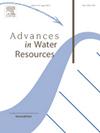具有连通性特征的异质含水层中的密度驱动自由对流
IF 4
2区 环境科学与生态学
Q1 WATER RESOURCES
引用次数: 0
摘要
自由对流通常发生在密度可变的地下水流系统中,与单纯的平流和扩散/弥散相比,自由对流通过扩大长度尺度和缩短时间尺度而有利于污染物的迁移。以往的研究表明,在密度驱动的对流过程中,具有对数渗透率(log10k)多变量高斯分布的异质性在不稳定性的发生、增长和/或衰减方面起着重要作用。然而,天然含水层中常见的连通性特征(即 k 值极高/极低的连通结构)却很少受到关注。本研究对经典的瞬态自由对流问题进行了修改,并采用蒙特卡罗方法进行了数值模拟,以研究异质性中的连通性特征对不稳定对流过程的影响。结果表明,自由对流主要在质量加载的早期阶段受到连通的高 K 结构的促进,而受到连通的低 K 结构的阻碍。连通性特征的影响往往会因 log10k 分布的较大变化而放大,其次还会受到相关长度和各向异性的影响。在多变量高斯假设下,连通性高k结构的存在会导致低估密度驱动的不稳定性,其中的风险根据渗透率场的统计、感兴趣的指标和时间范围而有所不同。这项研究强调了在评估地下水系统中依赖密度的溶质输运时,了解异质地质介质中连通性特征的重要性。本文章由计算机程序翻译,如有差异,请以英文原文为准。
Density-driven free convection in heterogeneous aquifers with connectivity features
Free convection usually happens in variable-density groundwater flow systems, and it favors contaminant transport by enlarging length scales and shortening timescales compared to advection and diffusion/dispersion alone. Previous studies have demonstrated that heterogeneity with multi-variate Gaussian distribution for logarithmic permeabilities (log10k) plays an important role in the onset, growth, and/or decay of instability during the density-driven convective process. Nevertheless, the connectivity features (i.e., connected structures of extremely high/low-k values), which are common in natural aquifers, have received little attention. In this study, the classical problem of transient free convection has been modified and numerically simulated by Monte Carlo approach to investigate the effects of connectivity features in heterogeneity on the unstable convective processes. Results show that free convection is promoted by the connected high-k structures and retarded by the connected low-k structures during mainly the early-stage mass loading. The impacts of connectivity features tend to be amplified by higher variation in log10k distributions, and can be secondarily influenced by correlation lengths and anisotropy. Under the multi-variate Gaussian assumption, the existence of connected high-k structures leads to underestimation of density-driven instability, in which the risk differs based on the statistics of permeability fields, metrics of interest and timeframe. This study highlights the importance of understanding connectivity features in heterogeneous geological media when assessing density-dependent solute transport in groundwater systems.
求助全文
通过发布文献求助,成功后即可免费获取论文全文。
去求助
来源期刊

Advances in Water Resources
环境科学-水资源
CiteScore
9.40
自引率
6.40%
发文量
171
审稿时长
36 days
期刊介绍:
Advances in Water Resources provides a forum for the presentation of fundamental scientific advances in the understanding of water resources systems. The scope of Advances in Water Resources includes any combination of theoretical, computational, and experimental approaches used to advance fundamental understanding of surface or subsurface water resources systems or the interaction of these systems with the atmosphere, geosphere, biosphere, and human societies. Manuscripts involving case studies that do not attempt to reach broader conclusions, research on engineering design, applied hydraulics, or water quality and treatment, as well as applications of existing knowledge that do not advance fundamental understanding of hydrological processes, are not appropriate for Advances in Water Resources.
Examples of appropriate topical areas that will be considered include the following:
• Surface and subsurface hydrology
• Hydrometeorology
• Environmental fluid dynamics
• Ecohydrology and ecohydrodynamics
• Multiphase transport phenomena in porous media
• Fluid flow and species transport and reaction processes
 求助内容:
求助内容: 应助结果提醒方式:
应助结果提醒方式:


